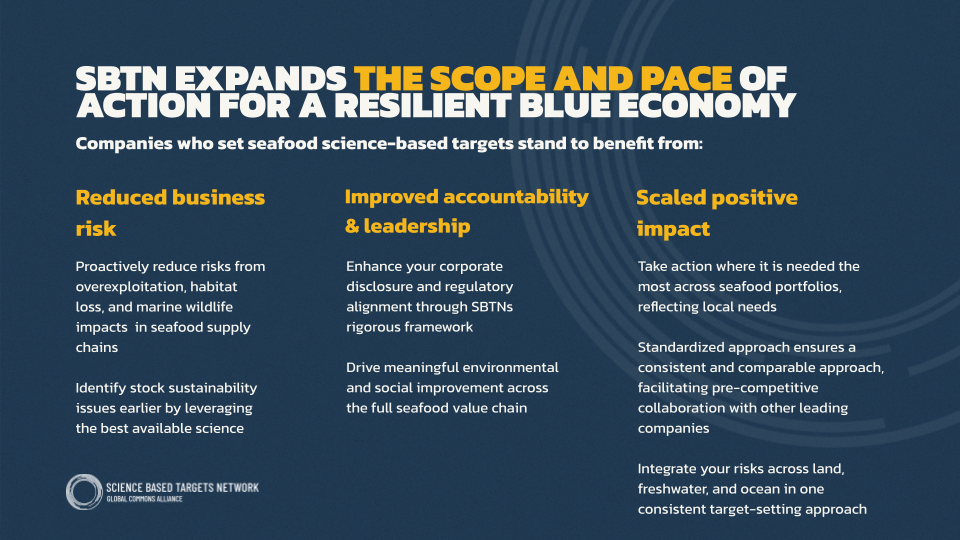Key takeaways
- The new targets cover the seafood sector only.
- They offer companies a structured way to address ocean sustainability and align their operations with scientific thresholds.
- Expanding engagement beyond seafood, into shipping, logistics and manufacturing, will further strengthen business resilience and ocean health.
The Science Based Targets Network (SBTN) has launched the first-ever ocean science-based targets, focusing initially on the seafood sector. This milestone completes SBTN’s initial suite of nature-related targets, alongside those for land and freshwater, and provides a structured, scientific framework for companies to address their ocean impacts.
For sustainability teams facing growing regulatory and investor scrutiny, adopting these targets will signal a commitment to improve biodiversity while addressing risks to global supply chains.
Why this matters
Continued overfishing, habitat destruction and biodiversity loss threaten both marine ecosystems and business resilience. Seafood providers, pharmaceutical companies and many other industries source directly from the ocean, and marine transportation is essential for worldwide trade. More than 80% of global trade by volume is transported via maritime shipping.
Despite these material risks, there is a dearth of corporate ocean commitments — especially those that go beyond blue carbon (i.e., carbon stored in marine ecosystems) to include biodiversity. SBTN’s new targets provide a pathway to bridge that gap, offering companies a structured way to address ocean sustainability and align their operations with scientific thresholds, ensuring long-term viability while mitigating reputational and regulatory risks.
“With the first ocean science-based targets for seafood, companies now have a globally recognized framework to scale action across land, freshwater and ocean,” said Erin Billman, executive director of SBTN. “These targets help companies move beyond incremental change, strengthening marine ecosystems, supply chain resilience and long-term viability.”
What’s included
Developed under the leadership of World Wildlife Fund and Conservation International — with input from key industry stakeholders like Sustainable Fisheries Partnership and the Aquaculture Stewardship Council — the targets were piloted in 2024 by four companies with materiality in the ocean and seafood systems, including Danish aquaculture company Musholm A/S and Orkla Foods in Sweden.
Following a public consultation, SBTN refined its approach to cover three key goals for companies in the seafood and aquaculture sector:

- Avoid and reduce overexploitation: Ensure sustainable sourcing of wild-catch fisheries and reduce reliance on overexploited stocks.
- Protect structural habitats: Address the impact of seafood operations on critical marine ecosystems, such as coral reefs and seagrasses.
- Reduce risks to marine wildlife: Mitigating risks from fishing and aquaculture practices on vulnerable marine species.
Each target includes multiple pathways for action, ranging from direct operational changes to engagement in jurisdictional and ecosystem-based initiatives. For example, a company sourcing wild-catch seafood may set a target such as: “By 2030, we will reduce sourcing of Atlantic blue marlin by 13 percent compared to a 2025 baseline.”
This ensures that overexploited stocks have time to recover while promoting sustainable practices.
An advance, but more is needed
The new targets represent a major step forward for corporate ocean action but only scratch the surface. Starting with fisheries makes sense. At the same time, many other industries also depend on healthy marine ecosystems. For example, pharmaceuticals and agriculture rely on marine resources, and marine-derived compounds are used in medicines and skincare. Fishmeal, meanwhile, is a key ingredient in animal feed.
Ensuring that these sectors recognize their role in ocean stewardship will be key to long-term success.
The ocean is also an emerging source of sustainable materials, such as seaweed-based plastic alternatives that could transform packaging and reduce dependence on fossil fuels. If marine ecosystems continue to decline, new opportunities will be be lost, fueling materials shortages and increasing costs.
We’ve already seen how fragile supply chains are when ocean access is restricted. The Ever Given blockage in 2021 delayed $9.6 billion in goods per day when a container ship ran aground and blocked the Suez Canal, and Red Sea attacks by Houthi forces have forced costly rerouting since 2023. While these disruptions resulted from physical blockages, marine ecosystem collapse could create similar risks at a systemic level.
SBTN’s targets lay a strong foundation, and expanding engagement beyond seafood, into shipping, logistics and manufacturing will further strengthen business resilience and ocean health.
What’s next
Companies in the seafood and aquaculture sector can now begin setting their own ocean-related science-based targets. Early adopters will not only position themselves as sustainability leaders but also gain a head start in regulatory alignment and supply chain resilience.
But for ocean sustainability to be truly effective, other industries beyond seafood producers must be held accountable as well. There’s growing recognition that investors and industry leaders can play a critical role in expanding targets beyond fisheries and creating a clear business case for broader ocean stewardship. The economic risks of ignoring ocean sustainability — disrupted supply chains, increased insurance costs for marine transport, loss of biodiversity affecting raw material availability — are too significant to overlook.
For more information, or to express interest in setting seafood science-based targets, visit SBTN’s Ocean Hub page.





